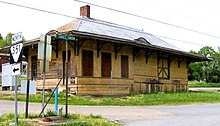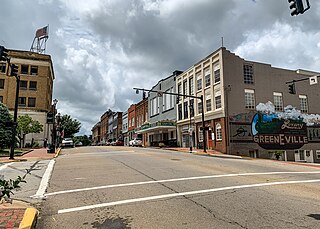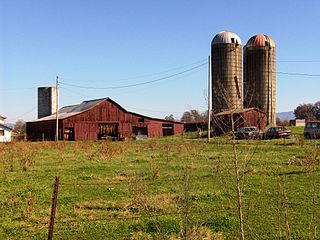
Chuckey is an unincorporated community in Greene County, Tennessee. [1] It is located on the Nolichucky River, from which its name is derived. The community is the site of a post office and is assigned zip code 37641.

Chuckey is an unincorporated community in Greene County, Tennessee. [1] It is located on the Nolichucky River, from which its name is derived. The community is the site of a post office and is assigned zip code 37641.
The defunct East Tennessee and Virginia Railroad formerly had a station in Chuckey. [2] The current brick train depot, built by the Southern Railway in 1906, [2] is listed on the National Register of Historic Places. Several farms in Chuckey that date from the community's earliest settlement in the 18th century are included in the Earnest Farms Historic District, also listed on the National Register. Just past the Earnest Farms Historic District sits an imposing ell-shaped brick mansion known as "Glaze Hall", built 1843–1849 by Lawrence Glaze, Jr.(1784–1849). The house sits on a rise overlooking the Nolichucky River, within sight of the old Smith Bridge. [3] The bricks used to construct the mansion were all hand-fired on the farm. Both Lawrence Glaze, Jr. and his wife, Elizabeth, died from an illness in 1849 before the house was to be completed. [3]
In the 1890s and early 1900s, Chuckey was home to aviation pioneer Edward Chalmers Huffaker (1856–1937). Trained as an engineer, Huffaker's 1895 paper, "The Value of Curved Surfaces in Flight," gained the attention of aviation enthusiast Octave Chanute, who helped Huffaker secure employment at the Smithsonian Institution. Huffaker worked with the Wright brothers at Kitty Hawk in 1901, but left after only one month due to consistent disagreement. [4] [5]
The first U.S. truffle orchard to successfully produce commercial quantities of culinary-quality black Périgord truffles is located in Chuckey. Tom Michaels, who had written a Ph.D. thesis on truffle cultivation, started cultivating truffles in the area in 2000 after observing that the area's limestone soil was similar to the soil of the Périgord region of France, where black truffles are native. [2] [6] In 2007, the first year that truffles were harvested from the orchard, it included 2,500 hazelnut trees growing on 20 acres (8 hectares) of land. Thirty pounds (14 kilograms) of truffles were produced in the first year. [7]
Chuckey Elementary School is located in Chuckey.
Chuckey-Doak Middle School and Chuckey-Doak High School are the feeder schools for Chuckey Elementary. They are both located in nearby Afton.

Washington County is a county located in the U.S. state of Tennessee. As of the 2020 census, the population was 133,001. Its county seat is Jonesborough. The county's largest city and a regional educational, medical and commercial center is Johnson City. Washington County is Tennessee's oldest county, having been established in 1777 when the state was still part of North Carolina. Washington County is part of the Johnson City, TN Metropolitan Statistical Area, which is a component of the Johnson City–Kingsport–Bristol, TN-VA Combined Statistical Area, commonly known as the "Tri-Cities" region.

Unicoi County is a county located in the U.S. state of Tennessee. As of the 2020 census, the population was 17,928. Its county seat is Erwin. Unicoi is a Cherokee word meaning "white," "hazy," "fog-like," or "fog draped," and refers to the mist often seen in the foothills and mountains of this far northeast county. Unicoi County is part of the Johnson City Metropolitan Statistical Area, which is a component of the Johnson City–Kingsport–Bristol, TN-VA Combined Statistical Area, commonly known as the "Tri-Cities" region.

Greene County is a county located on the eastern border of the U.S. state of Tennessee. As of the 2020 census, the population was 70,152. Its county seat is Greeneville. Greene County comprises the Greeneville, TN Micropolitan Statistical Area.

Newport is a city in and the county seat of Cocke County, Tennessee, United States. The population was 6,945 at the 2010 census, down from 7,242 at the 2000 census. The estimated population in 2018 was 6,801. Newport is located along the Pigeon River.

Greeneville is a town in and the county seat of Greene County, Tennessee, United States. The population as of the 2020 census was 15,479. The town was named in honor of Revolutionary War hero Nathanael Greene, and it is the second oldest town in Tennessee. It is the only town with this spelling in the United States, although there are numerous U.S. towns named Greenville. The town was the capital of the short-lived State of Franklin in the 18th-century history of East Tennessee.

Jonesborough is a town in, and the county seat of, Washington County, Tennessee, in the Southeastern United States. Its population was 5,860 as of 2020. It is "Tennessee's oldest town".

Brentwood is a city in Williamson County, Tennessee, United States. The population was 45,373 as of the 2020 United States census. It is a suburb of Nashville and included in the Nashville metropolitan area.

A truffle is the fruiting body of a subterranean ascomycete fungus, predominantly one of the many species of the genus Tuber. In addition to Tuber, over one hundred other genera of fungi are classified as truffles including Geopora, Peziza, Choiromyces, and Leucangium. These genera belong to the class Pezizomycetes and the Pezizales order. Several truffle-like basidiomycetes are excluded from Pezizales, including Rhizopogon and Glomus. Truffles are ectomycorrhizal fungi, so they are usually found in close association with tree roots. Spore dispersal is accomplished through fungivores, animals that eat fungi. These fungi have significant ecological roles in nutrient cycling and drought tolerance.

Belle Meade Historic Site and Winery, located in Belle Meade, Tennessee, is a historic house that is now operated as an attraction, museum, winery, and onsite restaurant together with outbuildings on its 30 acres of property. In the mid 19th century, the plantation encompassed roughly 5,400 acres with over a hundred enslaved persons.

The Sycamore Shoals of the Watauga River, usually shortened to Sycamore Shoals, is a rocky stretch of river rapids along the Watauga River in Elizabethton, Tennessee. Archeological excavations have found Native Americans lived near the shoals since prehistoric times, and Cherokees gathered there. As Europeans began settling the Trans-Appalachian frontier, the shoals proved strategic militarily, as well as shaped the economies of Tennessee and Kentucky. Today, the shoals are protected as a National Historic Landmark and are maintained as part of Sycamore Shoals State Historic Park.
David Crockett High School is a high school located in Jonesborough, Tennessee. It is one of two high schools in the Washington County School System and serves the southern part of the county. Its "rival" school is Daniel Boone High School, the other high school in Washington County, which serves the northern part of the county.

Limestone is an unincorporated community on the western border of Washington County and the eastern border of Greene County in the northeastern part of the U.S. state of Tennessee. Its zip code is 37681. Limestone is part of the Johnson City Metropolitan Statistical Area, which is a component of the Johnson City-Kingsport-Bristol, TN-VA Combined Statistical Area – commonly known as the "Tri-Cities" region.

Fort Watauga, also known as Fort Caswell, was a fortification located in the Watauga River's Sycamore Shoals near modern-day Elizabethton, Tennessee. It was constructed from 1775 to 1776 by the Watauga Association, a semi-autonomous government founded by American settlers living near the river, to defend the settlers against attacks from British-allied Indians. The fort was originally named Fort Caswell after the governor of North Carolina, Richard Caswell.

David Crockett Birthplace State Park is a state park in Greene County, Tennessee, United States. Situated along the Nolichucky River, the park consists of 105 acres (0.42 km2) centered on the traditional birthplace of legendary Tennessee frontiersman, soldier, and politician Davy Crockett (1786-1836). The park includes a replica of Crockett's birth cabin, a museum, and a large campground.

Sycamore Shoals State Historic Area is a state park located in Elizabethton, in the U.S. state of Tennessee. The park consists of 70 acres (28.3 ha) situated along the Sycamore Shoals of the Watauga River, a National Historic Landmark where a series of events critical to the establishment of the states of Tennessee and Kentucky, and the settlement of the Trans-Appalachian frontier in general, took place. Along with the historic shoals, the park includes a visitor center and museum, the reconstructed Fort Watauga, the Carter House and Sabine Hill . For over a thousand years before the arrival of European explorers, Sycamore Shoals and adjacent lands had been inhabited by Native Americans. The first permanent European settlers arrived in 1770, and established the Watauga Association—one of the first written constitutional governments west of the Appalachian Mountains—in 1772. Richard Henderson and Daniel Boone negotiated the Treaty of Sycamore Shoals in 1775, which saw the sale of millions of acres of Cherokee lands in Kentucky and Tennessee and led to the building of the Wilderness Road. During the American Revolution, Sycamore Shoals was both the site of Fort Watauga, where part of a Cherokee invasion was thwarted in 1776, and the mustering ground for the Overmountain Men in 1780.

Rose Hill Manor, now known as Rose Hill Manor Park & Children's Museum, is a historic home located at Frederick, Frederick County, Maryland. It is a 2+1⁄2-story brick house. A notable feature is the large two-story pedimented portico supported by fluted Doric columns on the first floor and Ionic columns on the balustraded second floor. It was the retirement home of Thomas Johnson (1732–1819), the first elected governor of the State of Maryland and Associate Justice of the United States Supreme Court. It was built in the mid-1790s by his daughter and son-in-law.

Washington College Academy was a private Presbyterian-affiliated educational institution located in Washington College, Limestone, Tennessee. Founded in 1780 by Doctor of Divinity Samuel Doak, the academy for many years offered accredited college, junior college and college preparatory instruction to day and boarding students, but financial difficulties in the 2000s forced the school to restructure its offerings and focus instead on continuing education courses for adults.

The Earnest Farms Historic District is a historic district consisting of four historic farms and associated structures near the community of Chuckey in Greene County, Tennessee, United States. The farms include the Elmwood Farm, the Broyles Farm, the Crum Farm, and the Jim Earnest Farm, all of which were initially developed by early pioneer Henry Earnest (1732–1809) and his descendants in the late-18th and 19th centuries. The district includes the Ebenezer Methodist Church, which is home to the oldest Methodist congregation in Tennessee, and the Earnest Fort House, which is one of the oldest houses in the state. Elmwood Farm has been designated a century farm and is one of the oldest farms in Tennessee, having been cultivated continuously since 1777.

Afton is an unincorporated community in Greene County, Tennessee.
Edward C. Huffaker was an American pioneer of manned flight best known for suggesting decades before anyone else that the Bernoulli Principle may allow curved wings to fly.